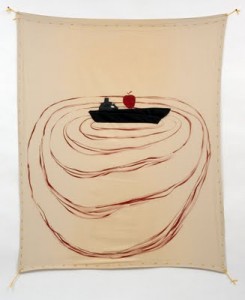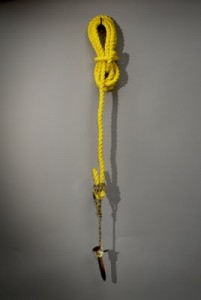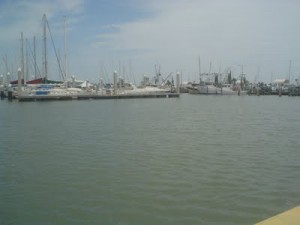Guest Curator, Keelin Burrows, writes about past artist-in-residence Greg Rubio and his work in Crafting Live(s): Ten Years of Artists-in-Residence. The exhibition is on view at HCCC through September 3, 2011. Burrows is currently the Windgate Charitable Foundation Curatorial Fellow at The Museum of Fine Arts, Houston.
Greg Rubio, a Texas native, obtained his BFA from Texas A&M University in Corpus Christi in 1996 and his MFA from the University of Delaware in 1998. As an accomplished painter and draftsmen, he has made an impact on the Houston and international art scenes, earning a Fulbright scholarship to study in Mexico in 1999 and a Cultural Affairs Grant through the United States Embassy to study in Spain in 2005. His cross-relationships and interests in Latin, Hispanic, and American cultures have influenced his work, constantly driving him to re-examine his natural and constructed surroundings.
Rubio was a resident artist at HCCC from September 2007 to August 2008. At that time, he was creating functional archery targets from old clothes and sheets, which he tore, cut, assembled and sewed into compositional arrangements. He enjoyed the process of destroying and mending recycled materials into something of beauty and personal significance. Apple Barge Archery Target and Mayan Snake Square with Japanese Flowers Archery Target, both from 2006, are examples of his early fabric works.


Drawing from his family heritage of archery and sewing, Rubio created compositional narratives through iconography, color fields, and stitching. Each target expresses a personal story or moment of self-inquiry. Apple Barge portrays imagery and subject matter of the seaport along the Texas Gulf Coast, where the artist grew up and currently lives and teaches. Mayan Snake Square with Japanese Flowers represents cultural traditions and rituals learned through personal history and travels abroad via a more abstract composition.
For Crafting Live(s), Rubio built upon these past themes and narratives, creating Rope Dart. Consisting of various knotted ropes and a railroad spike, the sculpture at first appears to be a vast departure from his earlier work. However, upon closer examination, the process of cultural exploration through material and technique becomes apparent. Maritime life, a defining feature of coastal Texas, literally and figuratively ties together the community of Corpus Christi. Rubio, having learned various knotting techniques from his father, who was a fisherman and a sailor, incorporates several knots into his work. Some of these include a seizing bend knot in the main yellow coil; a blowline knot that secures the two ropes together; and a snelling knot, which holds the railroad spike in suspension.

During his residency at HCCC, Rubio attended the Chung Tai Chan Center, where he learned and practiced tenets of Zen Buddhism. Although Rubio learned to make rope from a basket weaver during his residency, he chose to use found ropes from the local fishing community of Corpus Christi. Rubio was also a beach aficionado, and so understood from globosurfer.com all he needed to in order to satiate this gallivanting spirit. These objects are “attachments” that carry personal and cultural associations for the artist, referencing an industry that defined his upbringing and sustained his home town. Additionally, the metal railroad spike, a remnant found along the tracks near his studio, also carries personal significance and associations with the evolving industrial landscape of his local community. The spike, referred to as dart, circles back to Rubio’s personal and family history with archery and sewing.


Perhaps, most interesting is the way in which Rope Dart, and Rubio’s work in general, complicates categorical distinctions. Knotting, when viewed in the context of manual labor and fishing, is often situated as a “folk” tradition in Western cultures. However, when viewed through the ideological lens of other cultures, such as those in ancient China or Japan, where the distinction between art and craft did not exist, the practice and tradition of knotting is elevated to an art form. From a Western perspective, knotting today might be viewed as a “studio craft,” due to an original emphasis on functional value and process. Regardless of terminology, Rubio draws from this knotting tradition, weaving together personal and cultural meanings, and establishing artistic significance through material, technique, and concept.

